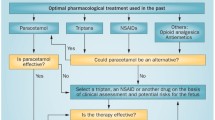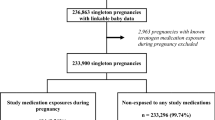Abstract
The high prevalence of migraine in women during their reproductive years means that new drug treatments for migraine, such as the serotonin 5-HT1B/1D receptor agonists (the ‘triptans’), are likely to be widely used by women of child-bearing potential. Scrutiny of these agents in an effort to detect any signal of teratogenicity is thus important.
A systematic review of the medical literature was conducted to identify information regarding the safety of sumatriptan during pregnancy. This agent was chosen to be investigated because it has been available for the longest and is the most widely used of the triptan class. Information was obtained regarding the impact of migraine on pregnancy outcome, and data on sumatriptan use in pregnancy were obtained from animal studies, preclinical drug trials, postmarketing surveillance efforts, prospective pregnancy registries, national birth registries and teratogen information services.
Synthesis of information from these sources is sufficient to rule out a large increase in birth defects from sumatriptan use during pregnancy and is reassuring for cases where inadvertent exposure to sumatriptan during pregnancy has occurred. However, current information is not sufficient to rule out small increases in the risk for birth defects. For this reason, caution should be exercised in making a positive recommendation for the use of sumatriptan during pregnancy.


Similar content being viewed by others
Notes
To make a report of sumatriptan exposure during pregnancy, call the following pregnancy registry numbers: North America, 1-800-336-2176 (toll-free); outside North America, 1-910-256-0549 (call collect).
References
Goadsby PJ. A triptan too far? J Neurol Neurosurg Psychiatry 1998; 64: 143–7
Ferrari MD, Saxena PR. Clinical effects and mechanism of action of sumatriptan in migraine. Clin Neurol Neurosurg 1992; 94: S73–7
Fowler PA, Lacey LF, Thomas M, et al. The clinical pharmacology, pharmacokinetics and metabolism of sumatriptan. Eur Neurol 1991; 31: 291–4
Silberstein SD, Lipton RB. Epidemiology of migraine. Neuroepidemiology 1993; 12: 179–94
Hu XH, Markson LE, Lipton RB, et al. Burden of migraine in the United States: disability and economic costs. Arch Intern Med 1999; 159: 813–8
Lipton RB, Scher AI, Kolodner K, et al. Migraine in the United States: epidemiology and patterns of health care use. Neurology 2002; 58: 885–94
Gaist D, Andersen M, Aarup AL, et al. Use of sumatriptan in Denmark in 1994–5: an epidemiological analysis of nationwide prescription data. Br J Clin Pharmacol 1997; 43: 429–33
O’Quinn S, Ephross SA, Williams V, et al. Pregnancy and perinatal outcomes in migraineurs using sumatriptan: a prospective study. Arch Gynecol Obstet 1999; 263: 7–12
Marcus DA, Scharff L, Turk D. Longitudinal prospective study of headache during pregnancy and postpartum. Headache 1999; 39: 625–32
Wainscott G, Sullivan FM, Volans GN, et al. The outcome of pregnancy in women suffering from migraine. Postgrad Med J 1978; 54: 98–102
Marcoux S, Berube S, Brisson J, et al. History of migraine and risk of pregnancy-induced hypertension. Epidemiology 1992; 3: 53–6
Olesen C, Steffensen FH, Sorensen HT, et al. Pregnancy outcome following prescription for sumatriptan. Headache 2000; 40: 20–4
Metropolitan Atlanta Congenital Defects Program procedure manual. Atlanta (GA): Centers for Disease Control and Prevention, 1996: A1–B11
GlaxoSmithKline Inc. Sumatriptan and naratriptan pregnancy registries: interim report, July 2002. Wilmington (NC): Pharmaresearch Corp., 2002: 1–39
Honein M, Paulozzi L, Cragan J, et al. Evaluation of selected characteristics of pregnancy drug registries. Teratology 1999; 60: 356–64
Kallen B, Lygner PE. Delivery outcome in women who used drugs for migraine during pregnancy with special reference to sumatriptan. Headache 2001; 41: 351–6
Shuhaiber S, Pastuszak A, Schick B, et al. Pregnancy outcome following first trimester exposure to sumatriptan. Neurology 1998; 51: 581–3
US Pharmacopeial Convention Inc. Drug information for the healthcare professional. Vol. 1. 15th ed. Rockville (MD): US Pharmacopeia Dispensing Information, 1995
Hughes HE, Goldstein DA. Birth defects following maternal exposure to ergotamine, beta blockers, and caffeine. J Med Genet 1988; 25: 396–9
Graham Jr JM, Marin-Padilla M, Hoefnagel D. Jejunal atresia associated with Cafergot ingestion during pregnancy. Clin Pediatr (Phila) 1983; 22: 226–8
Pfaffenrath V, Rehm M. Migraine in pregnancy: what are the safest treatment options? Drug Safety 1998; 19: 383–8
Feniuk W, Humphrey PP, Perren MJ. GR43175 does not share the complex pharmacology of the ergots. Cephalalgia 1989; 9Suppl. 9: 35–9
Acknowledgements
No funding was received for the preparation of this manuscript. Dr Loder is an unpaid member of the advisory committee for the sumatriptan/naratriptan pregnancy registry. She has been the principal investigator in numerous clinical trials of migraine medications, including sumatriptan, and has served as a consultant to GlaxoSmithKline, the manufacturer of sumatriptan.
Author information
Authors and Affiliations
Corresponding author
Rights and permissions
About this article
Cite this article
Loder, E. Safety of Sumatriptan in Pregnancy. Mol Diag Ther 17, 1–7 (2003). https://doi.org/10.2165/00023210-200317010-00001
Published:
Issue Date:
DOI: https://doi.org/10.2165/00023210-200317010-00001




